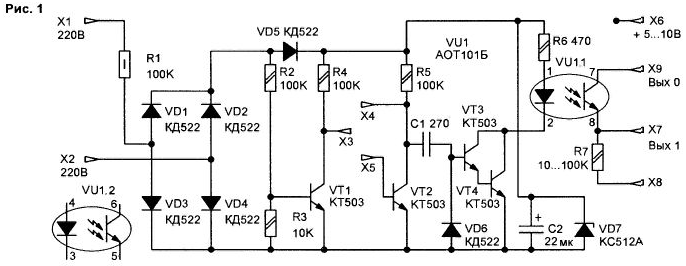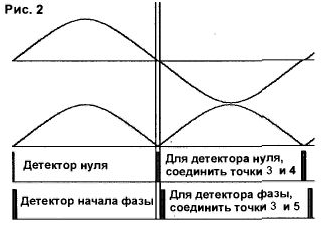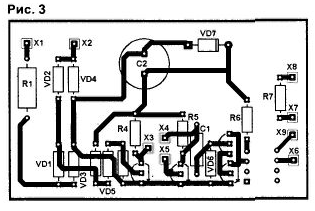The proposed device produces short pulses (0.3 to 1 MS) relative to zero (zero crossing) of the sine wave of the mains voltage. The output of the circuit is galvanically separated from the network. The device can be used to synchronize power thyristor blocks, as the generator frequency to 100 Hz (50 Hz), for quick definition of loss of mains voltage, etc. It also allows to generate momentum, starting in the early phase (phase detector).
Diagram of the device shown in Fig.1.

Resistor R1 limits current consumption at the level of 3 mA. The presence of this high resistance of the resistor with the Zener diode VD7 enables the use in the circuit of low-voltage capacitors, and diodes the transistors. Diode bridge VD1...VD4 converts the AC voltage into unipolar pulsating. Through the diode VD5 this voltage is applied to the circuit to power the circuit, the Zener diode limits voltage VD7, and the capacitor C2 smoothes pulsations. The capacitance of the capacitor C2 in the power supply circuit selected large (22 µf) when the device functions as a phase detector (otherwise it will be "blurred" the pulse top). If the steepness of the pulse is not critical, and in the scheme of the detector zero, the capacitance C2 can be reduced to 0.22 UF. When the specified capacitor C2 time between turning the device on to the network and the emergence of the first pulse is about 150...200 MS.
Simultaneously pulsing the voltage across the resistor R2 is supplied to the base transistor VT1, occasionally opening it, and at the collector of VT1 (point X3) appear short pulses with a duration of 0.2...0.3 MS. In an embodiment, detector zero between points X3 and X4 is enabled Then the jumper resistors R4 and R5 included in parallel, and the transistor VT2 is disabled. Rectangular pulses through the coupling capacitor C1 arrive at the base of the composite transistor VT3-VT4. Since the pulses at the collector of VT1 is short, the capacitor C1 does not have time fully charged, and when the specified capacity limits on the length of the pulse is not 's going on. Capacitor C1 discharges through the diode VD6 with the decline of the pulse.
A composite transistor, opening 0.2...0.3 MS, includes led coupler VU1. The current through the led of the selected about 12...15 mA. Led commutes the phototransistor is removed from the output signal, galvanically isolated from the network. On contacts X9 and X8 is powered by a voltage (5 ..10 In) from the scheme, where used, the signal detector. In this case, the phototransistor incorporated by the common-collector output, use the contact X7 (O. 1). The resistance R7 100 YM output pulses have flat fronts and a duration of about 1 MS. and with a resistance of 10 ohms is 0.3 MS with steep fronts. If you need to have the inverted signal"+" power fed to the contact X6,"-" - X7. the resistor R7 include between X6 and X9, and the signal is removed from output X9 (O.0).
In an embodiment of the phase detector jumper installed between pins X3 and X5. Pulses from the collector are fed to the base of VT1 VT2. On its collector signal is inverted, i.e. no within 0.2.-0.3 MS. Using pulses C1 collector VT2 proceed as in the previous embodiment. on a composite transistor VT3-VT4. Time diagram of the device for both options is shown in Fig.2.

In your device, you can use any low-voltage low-power transistors and diodes. Zener - voltage stabilization 9...15 In the Type of optocoupler is also not critical - anyone with the required insulation voltage (not less than 300). Resistor values not critical (47...200 kOhm), but when you decrease the resistance R1 increases its power dissipation that must be considered. Current consumption the device is about 2 mA, but it can be reduced by increasing the resistance R1. The detector is assembled on a printed circuit Board, a drawing of which is shown in Fig.3.

Author: V. Ponytail, S. Caredarovka Kharkiv region.






